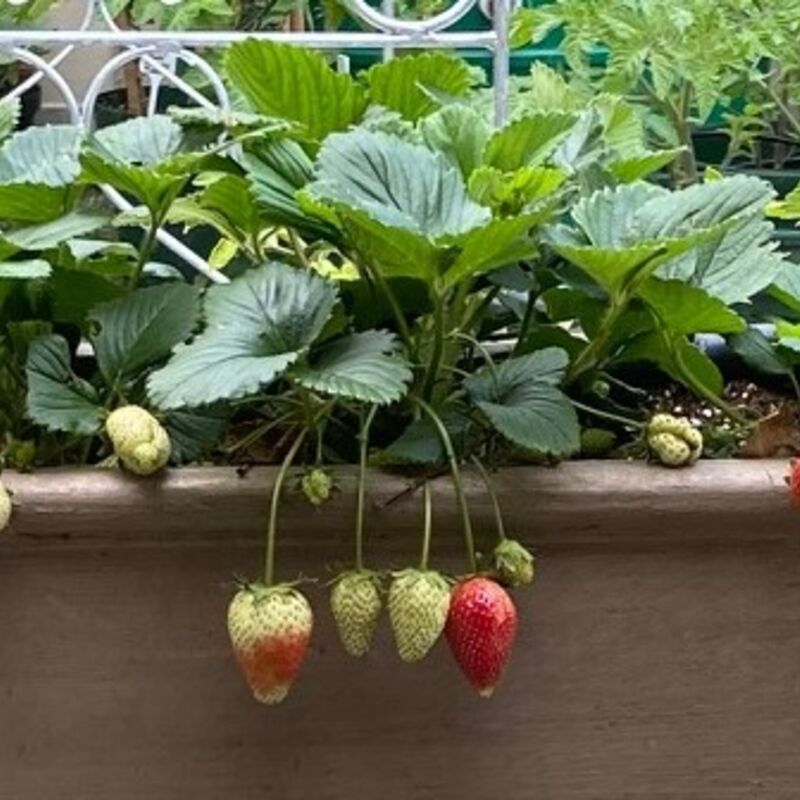Strawberries

Strawberries
Over the last few years, I have grown strawberry plants from cuttings known as runners obtained from a starter plant I purchased a few years previously.
This year (2021) I have created a container section that includes a sub-section on strawberries to help me record the outcomes of my strawberry browing activities.
I start growing the strawberries in late spring or early summer and use a row of terracotta containers to grow my strawberries which I mix with a few herbs.
Runners (cuttings) can usually be kept in the fridge for a few days before planting, while starter plants can survive in their pots from the nursery. Don't wait more than a few days to grow, however.
Planting runners
Use premixed potting soil with a pH between 5.5 and 6.5, or use compost. Fill the container to about 1 inch (2.5 cm) below the top.
For large and heavy pots, load the bottom of the pot with small rocks or ceramic pieces.
Place landscaping fabric on top before filling with soil which will help the container drain. It will also make the pot lighter than it would be if it were filled with soil, helping you move it if needed.
Dig a deep enough hole for your strawberry's roots, place them in the cavity, cover them with soil, and water the soil around the strawberries.
The green, thickened stem (called the crown) should sit just above the soil's surface, while the top of the roots should sit just below the surface, and separate plants about 10–12 inches (25–30 cm) apart.
Caring for plants
My strawberries are grown outside and get about 6-10 hours of sunlight a day during summer.
I water my plants with soaker pipes connected to my automated irrigation system that supplies 5 minutes of water in the morning and afternoon during summer.
Water the plant whenever the soil gets dry.
It is better to water a little bit more often than to overwater the plant at one time. If standing water remains in the pot after you've watered, cut back on how much water you give the plants.
I give the plant liquid fertilizer every two weeks in the spring and summer. Potted strawberries often require fertilizer because they cannot get nutrients as quickly from the soil. Use a 10-10-10 fertilizer or use a special mix, such as a liquid tomato feed. Follow the instructions on the label for fertilizing your plant.
If you notice holes on your leaves, discoloured leaves, or nibbled berries, you may have pests eating on your berries. Insecticidal soaps or products containing neem are effective against caterpillars, thrips, and beetles. Follow the instructions on the label before using it.[
For most pesticides, spray it directly onto the leaves, either in the early morning or evening.
If birds eat your berries, drape a net or mesh over the plant to keep them away.
Strawberries can quickly develop fungus. You may notice powdery spots or discolouration on the leaves; if so, keep potted strawberries away from tomatoes, potatoes, and eggplants, as these are common carriers of fungus that can spread to strawberries, and:
· Water, the base of the plant and not the leaves, can help prevent fungus from growing.
· Remove any leaves with fungus to prevent it from spreading to other parts of the plant.
Since containers can't get nutrients from the ground, it is essential to replenish the soil in the pot each year towards the start of the season. I mix fresh compost into the top layer of soil in the container and do not replace all of the soil.
Get rid of runners unless you want to grow new strawberry plants. Your strawberry plant will put out long, leafless vines. Seedlings and roots will grow from these runners for new plants, but they will also divert energy from berry production. Cut these runners off with a pair of gardening shears.
If you want to grow new strawberry plants, keep the runners. Pin the small plantlet on the stalk into the soil using a hairpin or a piece of wire. Once it sprouts leaves, cut it free from the mother plant and move it to a separate container.
Harvest the strawberries when they turn mostly red. Harvest all strawberries once they ripen, and don't leave any rotting berries on the bush. To pick the berries, twist the stem off the plant. Wash the strawberries before eating.